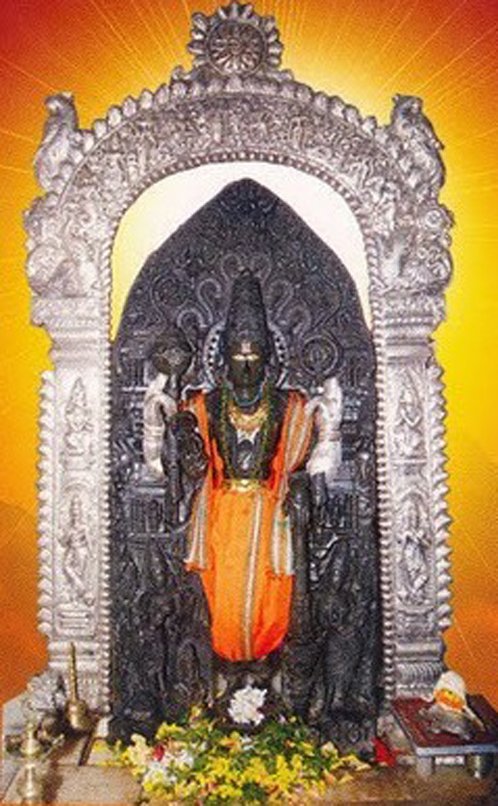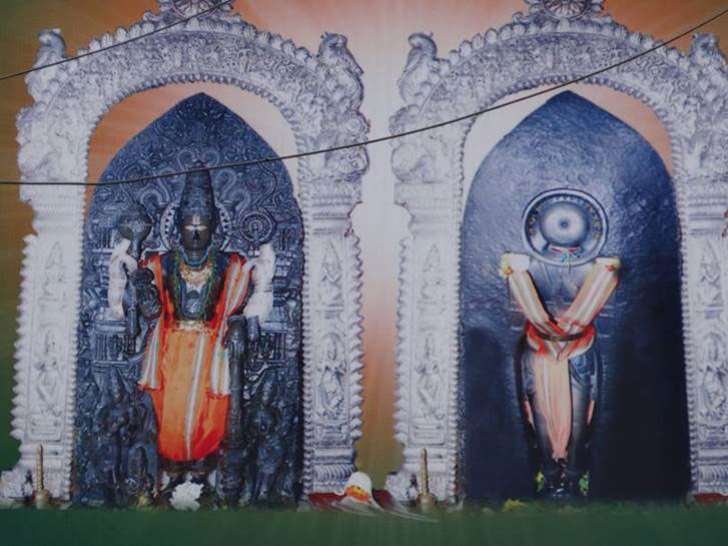In local language Ryali means fall. As per Bhagavatam, Lord Vishnu takes the guise of Mohini to rescue Devatas against Rakshasas during Samudra Mathana for getting Amrutam . During equally distributing the Amrutham among Devatas and Rakshasas, Mohini works in favour of Devatas and avoids the nectar by giving to Rakshasas.
Shrine’s History
“Ryali” in Telugu means falling. According to the legend “Bhagavatam, ” the Devatas and Rakshas were quarrelling over sharing of holy Devine nectar.Seeing this, “Sri Maha Vishnu” came to the rescue of Devatas in the guise of Mohini and convinced both the rivalry groups promising to distribute holy Devine nectar in equal share to Devatas and Rakshas. But in the interest of universal peac, the Devine nectar was distributed among Devatas alone and after which Mohini disappeared. Lord Siva happened to see the fascinating beauty of Mohini. He chased her forgetting for a while in the presence of his consort Parvathi Devi. As he was chasing her, flower from the plait of Mohini fell down and was smelt by Lord Siva. He surprisingly found “Sree Maha Vishnu” in the form of Mohini and felt shy for his behaviour. The place where the flower from the plait of Mohini fell was named as RYALI.

Legends Associated with This Shrine
According to the legend “Bhagavatam” while Devatas and Rakshas were quarrelling over sharing of holy Devine nectar “Sree Maha Vishnu” came to the rescue of Devatas in the guise of Mohini and convinced both the rivalry groups promising to distribute holy Devine nectar in equal share to Devatas and Rakshas. But in the interest of universal peace and welfare of sages, holy and Devine nectar was distributed among Devatas alone and the Mohini disappeared. Lord Siva having seen the most fascinating beauty of Mohini allured her. He chased her for getting for a while the presence of his consort Parvathi Devi it is the general belief that the holy incident was the result of birth of “AYYAPPA SWAMY”. One flower from the plait of Mohini fell down and it was smelt by Lord Siva. Then he surprisingly found “Sree Maha Vishnu” in the form of Mohini and felt shy for his behavior. The place where the flower from the plait of Mohini fell is named as RYALI the Telugu meaning of “Fall”.
This place known as Ryali for the above reason became above of Lord Siva and Sree Mahavishnu with the form of Mohini on back side Lord Brahma consecrated the Siva Lingam with his Kamandalam and hence Lord Siva at Ryali is worshipped as Sri Uma Kamandalesara Swamy Varu, Sri Mahavishnu with the form of Mohini on backside is worshipped as Sri Jaganmohini Kesava Swamy varu both Siva and Vishnu Temples are located facing each other. This is very rare feature at Ryali where Vishnu and Lord Siva Temples faces each other in East, West direction. During the 11th Century, this village was a part of wild Forest and these parts were under the rule of Chola Rajas. Sri Raja Vikrama Deva who ruling these parts during those days came to this place for hunting. Having been tired after hunting wild animals, he took rest under the shade of a big ponna tree, and fell in deep sleep and got a dream.
Lord Sri Maha Vishnu appeared in his dream and informed that his shrine was located in the under ground of this area and directed the “Raja to get the wooden made chariot pull in the area and where the nail of chariot fell, the shrine can be found in the under the ground of that place. Raja has done accordingly and the land where the nail of chariot fell was excaved and found the idol making the dream of Raja true. He constructed a small temple during the 11th Century and arranged worship during his regime. Gradually prakarams were developed in the year 1936 it was renovated.The Shrine of Sri jaganmohini kesava Swamy varu is Salagrama Ekasila with 5 feet height and 3 feet width. Gopuram of Lord Jaganmohini Kesava & Gopala Swamy Temple Salgramasila is itself the form of Sri Maha Vishnu.
The idol of Sree Kesava Swamy varu of “Sri Mahavishnu” in a front side and Jagan Mohini on a back side. The tem incarnations Lord Sree Maha Vishnu with consorts, Sri Devi, BhooDevi, Sage Narada, Thumbura, Rambha, Urvasi, Kinnera, Kimpurusha, Lord Krishna with Govardhanagiri, Adiseshu, Garuda and Ganga are beautiful, sculptured around the shrine. The most miracle and rare feature are that Ganga always flows from the feet of Sri Maha Vishnu is the origin of Akasa Ganga and this truth can be witnessed here.
The most wonderful architectural beauty of Shrine and flow of Ganga from the feet of Swamy varu are really unique features and shrine became very sacred. The architectural beauty of idol can not be described in words. Further, it gives an impression as it is new idol though its origin is of 11th Century.This shrine is “SWAYAMBHU” people visiting the temple form several parts of the Country believe that the shrine is not of man-made but certainly a creation of Devatas and Darsan of Swamy varu gives the feeling of the presence of real God.

Shrine’s Map Location and How to Go There
By Road
The nearest bus stop is Rajamundry
By Rail
The nearest Railway station is Rajamundry.
By Air
The nearest airport is Rajamundry
Shrine Timings
6.00am to 12.00noon and from 3.00pm to 8.00pm
Events Celebrated at This Shrine
1Sri Jaganmohini Kesava Swamy kalyanam which is from Chaitra Shudha Navami to Pournami which is during March/April.
2. Sri Rama Satyanarayana Swamy kalyanam which is from Vishakha Sudha Ekadasi to Pournami.
3. Sri Venugopala Swamy kalyanam which is from Jyestha Sudha Ekadasi to Pournami in the month of June.
4. Shravana Bahula Ashtami which also known as Sri Krishnastami in August.
5. Karthika Shuddha Dwadasi which is also known as Ksheerabdhi Dwadasi held in November.
6. Devi Navaratri in October.
7. Mukkoti Ekadasi.
8. Bheeshma Ekadasi.













































